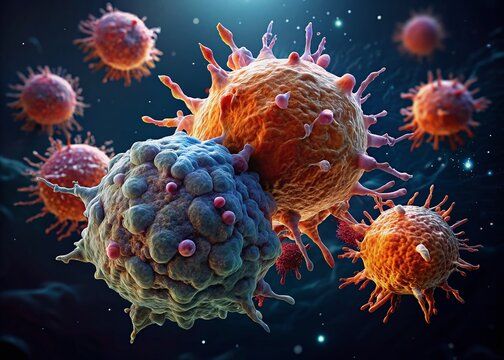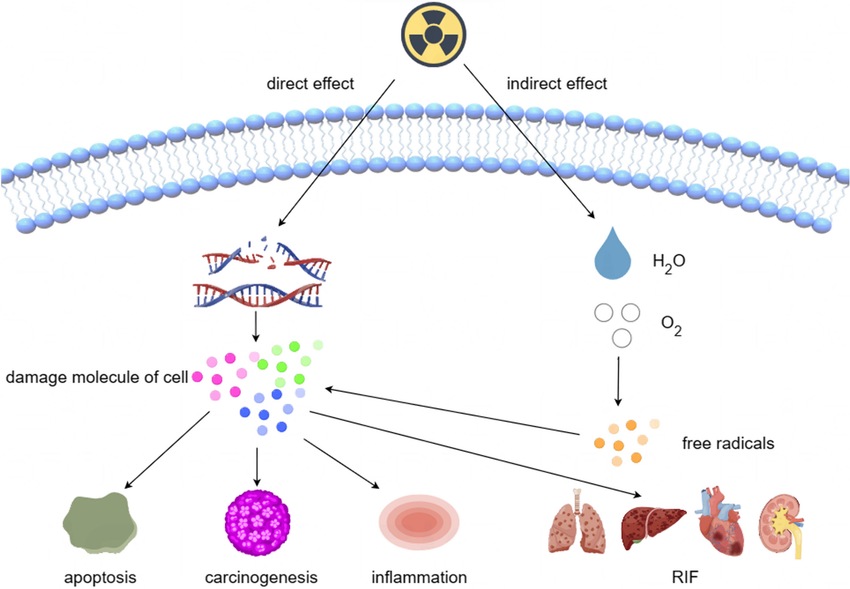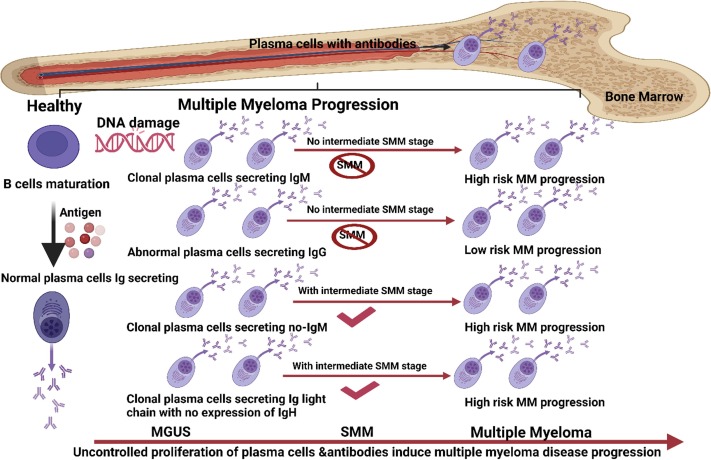
At its core, cancer is a disease of the cell. To comprehend its origins and progression, one must first understand the fundamental process that governs the life of every cell: the cell cycle. This intricate and highly regulated sequence of events dictates when a cell grows, replicates its genetic material, and divides. The disruption of this delicate balance is the foundational principle of oncology.
The Normal Cell Cycle and Its Deregulation in Cancer
The ability of an organism to grow, repair tissues, and maintain homeostasis depends on the precise regulation of cell division. This regulation is managed by the cell cycle.
The Phases of a Normal Cell Cycle
The cell cycle is an ordered series of events, divided into four main phases, controlled by internal and external signals and a series of critical checkpoints.
- Step 1: G1 Phase (Gap 1): Following cell division (mitosis), a new cell enters the G1 phase. This is a period of significant growth and metabolic activity. The cell synthesizes proteins and organelles, increasing in size. Critically, near the end of G1 lies the G1 checkpoint (or Restriction Point). Here, the cell assesses conditions: Are nutrients sufficient? Is the DNA undamaged? Are there positive growth signals? If these conditions are met, the cell commits to division and proceeds to the S phase. If not, it may enter a quiescent, non-dividing state called G0.
- Step 2: S Phase (Synthesis): Once past the G1 checkpoint, the cell enters the S phase. The sole purpose of this phase is to replicate the entirety of its DNA. Each of the 46 chromosomes is duplicated, resulting in two identical sister chromatids joined together. This process must be executed with extremely high fidelity to prevent mutations.
- Step 3: G2 Phase (Gap 2): After DNA synthesis is complete, the cell enters the G2 phase. It continues to grow and synthesizes proteins required for mitosis. The G2/M checkpoint occurs at the end of this phase, ensuring that DNA replication is complete and that any DNA damage has been repaired before the cell enters the most dynamic phase of division.
- Step 4: M Phase (Mitosis): This is the phase of physical cell division. It is subdivided into prophase, metaphase, anaphase, and telophase, culminating in cytokinesis (the division of the cytoplasm) to form two genetically identical daughter cells. A third crucial checkpoint, the Spindle Assembly Checkpoint, operates during metaphase to ensure that all chromosomes are correctly attached to the mitotic spindle before they are segregated into the daughter cells.
The Fundamental Principle of Cancer: Loss of Control
Cancer is fundamentally a disease of uncontrolled cell proliferation. The fundamental principle is that cancer cells have acquired defects that allow them to bypass the cell cycle checkpoints. They no longer heed the signals that would normally halt their progression. They may:
- Ignore signals to stop dividing.
- Divide in the absence of positive growth signals.
- Override the checkpoints that detect DNA damage, leading to the accumulation of mutations.
- Fail to enter the G0 resting state.
This relentless and unregulated progression through the cell cycle is what drives the formation of a tumor.
The Hallmarks of Cancer: Essential Alterations in Malignant Transformation
For a normal cell to transform into a malignant one, it must acquire a series of capabilities. These were famously categorized by researchers Douglas Hanahan and Robert Weinberg as the “Hallmarks of Cancer.” These are the essential alterations that collectively enable tumor growth and metastatic dissemination.
- Alteration 1: Sustaining Proliferative Signaling: Normal cells require external growth factors to divide. Cancer cells circumvent this by developing the ability to generate their own growth signals, overexpressing growth factor receptors, or altering intracellular signaling pathways to be constitutively “on.”
- Alteration 2: Evading Growth Suppressors: The cell cycle is controlled by “brake” proteins known as tumor suppressors (e.g., p53, Rb). These proteins enforce the checkpoints. Cancer cells acquire mutations that inactivate these suppressor genes, effectively removing the brakes on cell division. The inactivation of the p53 gene, the “guardian of the genome,” is found in over 50% of human cancers.
- Alteration 3: Resisting Cell Death (Apoptosis): When a cell suffers irreparable damage or is no longer needed, it undergoes programmed cell death, or apoptosis. This is a critical self-destruct mechanism that eliminates potentially dangerous cells. Cancer cells develop mechanisms to evade apoptosis, allowing them to survive despite severe genetic abnormalities.
- Alteration 4: Enabling Replicative Immortality: Normal cells can only divide a finite number of times, a limit dictated by the shortening of protective chromosome caps called telomeres. Cancer cells often reactivate an enzyme called telomerase, which rebuilds the telomeres, granting them the ability to divide indefinitely.
- Alteration 5: Inducing Angiogenesis: As a tumor grows, it requires its own blood supply to deliver oxygen and nutrients. Cancer cells achieve this by secreting signaling molecules (like VEGF) that stimulate the growth of new blood vessels into the tumor mass, a process known as angiogenesis.
- Alteration 6: Activating Invasion and Metastasis: The deadliest aspect of cancer is its ability to metastasize. This involves a multi-step process where cancer cells lose their adhesion to the primary tumor, invade surrounding tissues, enter the bloodstream or lymphatic system, travel to distant sites, and form secondary tumors.
The Engine of Growth: Proto-Oncogenes, Growth Factors, and Their Receptors
The first hallmark—sustaining proliferative signaling—is driven by a specific set of molecular players. Understanding this signaling pathway is key to understanding how cancer begins.
The Steps of Cell Proliferation Signaling
- The External Signal (Growth Factors): The process typically begins with a signaling molecule called a growth factor (e.g., Epidermal Growth Factor – EGF, Platelet-Derived Growth Factor – PDGF). These are proteins secreted by other cells that act as a “go” signal for division.
- The Receiver (Growth Factor Receptors): The target cell has growth factor receptors on its surface. These are transmembrane proteins that act like antennas. When a growth factor binds to its specific receptor, the receptor changes shape and becomes activated.
- The Internal Relay (Signal Transduction): The activated receptor initiates a chain reaction inside the cell known as a signal transduction cascade. This relay race involves a series of proteins that activate one another in sequence, carrying the “divide” signal from the cell membrane to the nucleus. A famous and critically important pathway is the RAS-MAPK pathway.
- The Command Center (Transcription Factors): The signal ultimately reaches the nucleus, where it activates transcription factors (e.g., MYC, JUN, FOS). These are proteins that bind to DNA and control which genes are “read” and turned into proteins.
- Executing the Order (Cell Cycle Progression): These transcription factors switch on the genes for proteins essential for cell cycle progression, such as cyclins and cyclin-dependent kinases (CDKs). These proteins are the master regulators that physically push the cell past the G1 checkpoint and into the S phase, committing it to division.
From Friend to Foe: Proto-Oncogenes and Oncogenes
The genes that code for the proteins in this growth-promoting pathway (growth factors, receptors, signaling proteins, transcription factors) are called proto-oncogenes. In their normal state, they are essential for controlled cell growth and repair—they are the “gas pedal” of the cell.
However, when a mutation occurs in a proto-oncogene, it can become an oncogene (“cancer gene”). An oncogene is a permanently activated version of the proto-oncogene.
- A mutation might cause a growth factor receptor (like HER2) to be permanently “on,” even without a growth factor present.
- A mutation in a signaling protein (like RAS) can make it stuck in its active state, constantly telling the cell to divide.
This “gain-of-function” mutation creates a cell that no longer waits for an external signal to grow. It has its own internal, perpetually active “gas pedal,” driving the uncontrolled proliferation that defines cancer.
References:
- Hanahan, D., & Weinberg, R. A. (2000). The Hallmarks of Cancer. Cell, 100(1), 57–70.
- Hanahan, D., & Weinberg, R. A. (2011). Hallmarks of Cancer: The Next Generation. Cell, 144(5), 646–674.
- Weinberg, R. A. (2014). The Biology of Cancer (2nd ed.). Garland Science.
- Alberts, B., Johnson, A., Lewis, J., et al. (2015). Molecular Biology of the Cell (6th ed.). Garland Science. Chapter 17, The Cell Cycle, and Chapter 20, Cancer.







